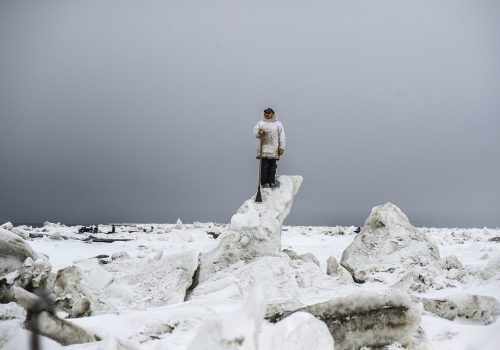Yuri Kozyrev and Kadir van Lohuizen have explored the North Pole and brought back a striking reportage that shows the colossal stakes in this part of the world. The work of the laureates of the 9th edition of the Carmignac photojournalism award is exhibited at the Cité des sciences and industry in Paris.
Four reindeer pulling a sled in the snow. In the distance, a group of buddies advance in single file and disappear on the horizon … This is the photograph that welcomes the visitor who come to see this exhibition. A photograph of Yuri Kozyrev taken on the Yamal Peninsula in Russia, where nénete breeders lead their cattle from winter pastures to summer pastures. This year, for the first time, they could not complete transhumance because of the melting of the permafrost. So we are directly immersed in what is the strength of this incredible reportage proposed by the two photographers: the effects of global warming on this region of the world and the impact on local populations.
Norilsk
It was a tour of the Arctic Circle that Yuri Kozyrev and Kadir van Lohuizen made. The first, Russian, went to his country of origin. The second, a Dutchman, traveled to Greenland, Canada and Alaska United States. The two winners of the 9th edition of the Carmignac Prize for Photojournalism each received 50,000 euros to go fishing for these never seen images. They offer us a large coverage of this little-known area that has so many issues … In Russia, Yuri Kozyrev first presents the huge factories that run full throttle in the middle of a frozen land, as in Norilsk, 180,000 inhabitants almost all employees in the world’s largest mining and metallurgical complex. Here, is a nickel factory that has just closed its doors after spitting 350,000 tons of sulfur dioxide a year. There, in Sabetta, is one of the largest natural gas liquefaction plants in the world, built by Novatek in collaboration with Total. There, in Murmansk, is a floating nuclear power plant that will soon change home port.
Mammoths
An unsuspected world is revealed by the photographer. Mammoth defense hunters have just found one and will be able to sell it at a price that will largely reimburse their expedition. A young woman in a pink dress poses in front of a frozen lake in Nadym, a city of 47,000 inhabitants. The caption tells us that she has just celebrated with her friends the end of the school year. Portrait of the inhabitants of places that are the first affected by global warming. Here, in the Arctic, it reaches records high. The ice floe has lost half of its volume since 1979. For the first time, in 2010, a container ship was the first in the world to cross the Arctic via the Northeast Passage, from Murmansk to Shanghai, without the assistance of an icebreaker, and in just one month. In the far north, the roads are clearing because the ice is melting at a speed never seen before and all bordering countries bite the bullet waiting to invest this part of the world extremely rich in various resources.
Tourism
This melting ice obviously causes a rise in water. A disaster for the coastal peoples. Kadir van Lohuizen photographed this village in Alaska: Kivalina. There, people do not have running water and have to stock up at the communal tap. In 2025, according to scientists’ forecasts, the place will be under water. Locals would like to move 12 kilometers away, but the total budget is estimated at $ 100 million and is yet to be found … Tragedy of a countdown that has already begun. Especially since this part of the world as shown by Kadir van Lohuizen is also threatened by tourism. A “last chance” tourism that comes to watch a world disappearing and participates, in this disappearance. The most to be pitied are the local people who see that their traditions are impossible to maintain, like this whale hunter, a harpoon in hand, standing over a block of ice and watching for his prey. His village is allowed to hunt ten bowhead whales per year. But because of the melting ice, the whales are freer of their movements and it becomes more difficult to hunt them. These Inuit people use the large bones of the whale’s jaws to mark the boundaries of the village cemetery. An astonishing photograph of Kadir van Lohuizen attests to this: we see crows dancing in the air around these bones standing in the middle of a snow desert.
Jean-Baptiste Gauvin
www.fondationcarmignac.com/fr/photojournalisme/la-mission
















